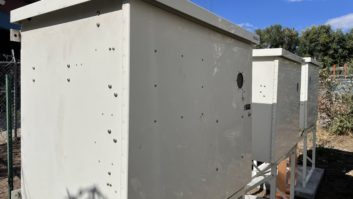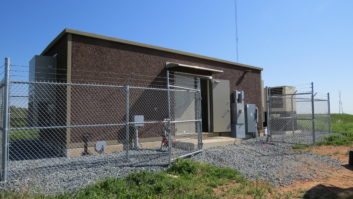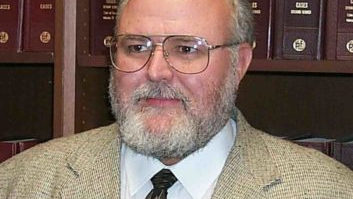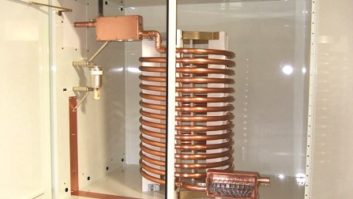Diplexing AM transmitters
Sep 1, 2002 12:00 PM, By John Battison, P.E., technical editor, RF
Throughout the years that radio broadcasting has existed there has not been a strong need to operate more than one AM transmitter into a single antenna. However, during the past several years vertical real estate has become increasingly valuable due to economic factors affecting large tracts of open land. The frantic efforts of the anti-tower consortium to stop the erection of as many towers as possible, together with FAA restrictions, have also added to the value of existing transmitting antennas and their sites. Consequently, the idea of feeding two or more transmitters into a single tower is becoming increasingly attractive and more stations are finding it necessary to diplex to stay viable, or even find a suitable site.
Figure 1. Block diagram of a common, diplexed non-directional installation.

The roadblocks put in the way of new tower construction seem to be increasing exponentially. Businesses that fall under the heading of public utilities can usually force acceptance of a new tower in places where they are banned. Unfortunately, despite the FCC’s publicized �law� that is supposed to supersede local zoning regulations, the Commission has given little assistance to broadcasters coming up against zoning roadblocks. New permittees have to find a willing competitor who will rent radiating space on an existing tower.
Diplexing FM transmitters, or even triplexing is not unusual today. The same precautions have to be taken as for diplexing AM transmitters but to a greater extent. The major differences are that while almost any radiator will perform for AM, sometimes with minor modifications, FM antennas have to be specially broadbanded to cover all the desired transmitter frequencies. FM costs are usually higher unless the originally installed antenna was designed for this purpose. Another major consideration is that a distance of as little as one foot can be critical in FM, and usually is far less critical in AM operations.
For AM non-directional operations, radiating two frequencies from a single antenna is easy to do. In the case of directional antenna systems dual frequency operation is possible, just more complex.
Where to begin
First confirm that the desired pattern for the new transmitter can be obtained using the existing towers, orientation and layout. The next step is similar to that for a single antenna but considerably more complex. After the directional array is designed it becomes a matter of designing isolating filters that provide clean signal passage to the desired signals, and effective acceptance networks to bypass the undesired signals to ground.
Figure 2. A modified diplexer. The added networks and antenna matcher overcome undesired electrical characteristics.

Sometimes antenna efficiency affects diplexing. If the existing station operates on a higher frequency than the new one, the existing antenna may not provide the required radiation efficiency on the lower frequency. This was a problem about 40 years ago when CBS allowed WNBC (now WFAN) on the new WCBS tower. The site is on High Island and surrounded by seawater, which gives excellent ground conductivity and coverage of New York City.
WCBS operates on 880kHz and WFAN is on 660kHz. Both are rated at 50kW. The shorter WCBS antenna did not provide the required FCC radiation efficiency on 660kHz. It took considerable work to bring the lower frequency efficiency up to the required level. In some cases, folded unipole techniques or some form of top loading may be required to increase the electrical length of the antenna for the lower frequency station, while not greatly increasing the radiation efficiency on the higher frequency unless such increased radiation can be approved with a new CP. Consider all the critical electrical length factors that are involved in constructing an antenna designed for multifrequency operation. The possibility of significant sum or difference frequencies being produced must be borne in mind in the planning stages.
Figure 1 diagrams diplexed nondirectional operation. The antenna circuit for each transmitter is similar. Between each ATU and the antenna is an accept/reject filter and an acceptance filter to bypass to ground the other transmitter’s signal. This is the bare bones circuit and would probably work well but it does not provide the desired attenuation of the other station’s signal. Audio quality may suffer from the effects of Hi Q circuits and bandwidth restrictions. A few modifications to the basic circuit will provide the best operating conditions. Sometimes it is possible to incorporate components of an ATU into various filters. However, this is not a good idea because it can make future adjustments difficult and can result in performance restrictions.
Figure 2 shows a diplex system modified to avoid problems of bandwidth restriction, impedance matching and excessive Q conditions. The higher-frequency side will be similar except that the frequencies of the accept/reject filters will be reversed.
The design of the main filter is important, but will be saved for a later column. The bandwidth of high and low frequencies will be affected by the design of this filter. Sometimes auxiliary filters are used and their presence affects the final main filter design.
Component stress has to be taken into account, especially 100 percent modulation current. Unsuspected high circulating currents can develop as well as unexpected high RF voltages.
Sometimes an antenna resonator is required when using an auxiliary trap. This resonator is actually a reactive device that may be positive or negative, depending on the impedance at the input to the main filter.
About 60dB attenuation between the transmitters is adequate. The amount of attenuation generally determines whether an auxiliary filter is required. If it’s less than 60dB the auxiliary filter will be needed. Anything less than 15 percent frequency separation will require an auxiliary filter. With more than 25 percent frequency separation an auxiliary filter will not be required.
E-mail Battison at[email protected].












